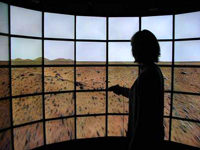The Varrier Autostereoscopic Virtual Reality Display
July 30th, 2005
Categories: Applications, Devices, Tele-Immersion

Authors
Sandin, D., Margolis, T., Ge, J., Girado, J., Peterka, T., DeFanti, T.About
Virtual reality (VR) has long been hampered by the gear needed to make the experience possible; specifically, stereo glasses and tracking devices. Autostereoscopic disply devices are gaining popularity by freeing the use from stereo glasses, however few qualify as VR displays. The Electronic Visualization Laboratory (EVL) at the University of Illinois at Chicago (UIC) has designed and produced a large scale, high resolution headtracked barrier-strip autostereoscopic display system that produces a VR immersive experience without requiring the user to wear any encumberances. The resulting system, called Varrier, is a passive parallax barrier 35-panel tiled display that produces a wide field of view, head-tracked VR experience. This paper presents background material related to parallax barrier autostereoscopy, provides system configuration and construction details, examines Varrier interleaving algorithms used to produce the stereo images, introduces calibration and testing, and discusses the camera-based tracking subsystem.
Resources
Citation
Sandin, D., Margolis, T., Ge, J., Girado, J., Peterka, T., DeFanti, T., The Varrier Autostereoscopic Virtual Reality Display, ACM Transactions on Graphics, Proceedings of ACM SIGGRAPH 2005, vol 24, no 3, pp. 894-903, July 30th, 2005.